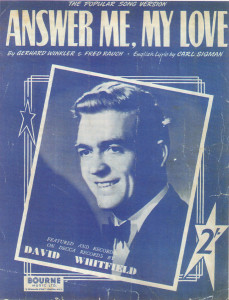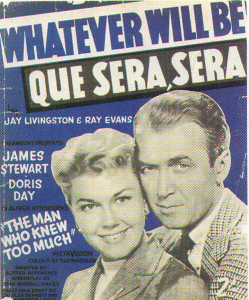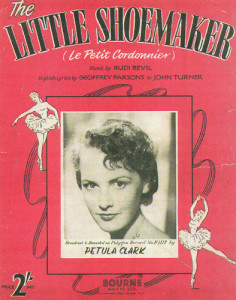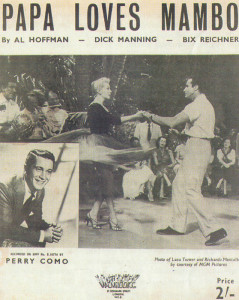 Mrs. Parry must have been close to giving up on me many times. As a schoolboy in the early 1950s, piano practice did not come high on my list of priorities – then the front room was not the most inviting place, even with the two-bar electric fire toasting my back as I ham-fisted my way through the Mozart’s Sonata in B Flat.
Mrs. Parry must have been close to giving up on me many times. As a schoolboy in the early 1950s, piano practice did not come high on my list of priorities – then the front room was not the most inviting place, even with the two-bar electric fire toasting my back as I ham-fisted my way through the Mozart’s Sonata in B Flat.
At Is 3d a time, the half-hour Monday evening music lesson was
not too much of a burden on family finances, though it clearly did not do much to boost Mrs. Parry’s housekeeping.
Both she and I knew that we were mutually engaged on something of a lost cause. It was a secret we kept to ourselves. There it was, at her house in Beechley Road circa 1951/2, that I would wrong-note my way through one piece after another before a giggling audience of pretty teenage girls, impatiently waiting on the sofa for their turn at the piano.
Yet for all that, I managed to pick up enough to sight read, of sorts, and tackle, albeit in the refrigerated privacy of the front room at home, some of the easier popular tunes of the day. The sheet music (Is – l/6d – 2s a copy) was bought on Saturday mornings from Crane’s (Crane & Sons), in Regent Street, in the North Wales home town of Wrexham. The music accumulated in those days, more than 46 years ago, of course now seems to belong to another world.
But it was not until recendy that it dawned on me just what an array of tattered treasures lay in the old piano stool that had once graced my grandmother’s home in Denbigh.
 The elderly upright piano, passed down from one generation to the next, was as much a symbol of that earlier traditional chapel-going age as the old mahogany piano stool. The family had been storing music in the stool since the 1920s, if not earlier. Along with a Welsh hymnal booklet of 1924 and a black leather-covered hymn book (Llyfr Hymnau), it also contained the 1930s News Chronicle Song Book (community songs, plantation songs, sea shanties, hymns and carols) and a severely torn but dated 6d copy of My Irish Paradise, featuring a top-hatted and monocled tenor, Talbot O’Farrell.
The elderly upright piano, passed down from one generation to the next, was as much a symbol of that earlier traditional chapel-going age as the old mahogany piano stool. The family had been storing music in the stool since the 1920s, if not earlier. Along with a Welsh hymnal booklet of 1924 and a black leather-covered hymn book (Llyfr Hymnau), it also contained the 1930s News Chronicle Song Book (community songs, plantation songs, sea shanties, hymns and carols) and a severely torn but dated 6d copy of My Irish Paradise, featuring a top-hatted and monocled tenor, Talbot O’Farrell.
The sheet music I began to collect, in
random fashion manv years later, contained lyrics and medleys that were as gentle and folksy as they ever had been. The rock’n’roll revolution of the mid-fifties was still a few years off.
The numbers included songs such as The Little Shoemaker (Le Petit Cord.on.nier), 1953, recorded by a delicately youthful Petula Clark, and the extraordinary patriotic The Windsor Waltz (1953), recorded by Dickie Valentine (in a looking-heavenwards pose on the cover). Then there was Answer Me, My Love (1954) from the German song Mutterlein, recorded by David Whitfield, as well as the equally-famous Cara Mia, which he recorded with Mantovani.
Another of the then top ballad singers was Jimmy Young, featured on the copy of the Spanish song Sway (Qien Sera) and, again, on More (1956). Then there was the 1956 musical comedy number Mr Wonderful, separately recorded by Peggy Lee, Marion Ryan, Ruby Murray, and The Bev-
erley Sisters. Another treasured copy featured that tranquilliser of a song, Whatever Will Be, Will Be (Que Sera, Sera), 1955, from the film The Man Who Knew Too Much with James  Stewart and Doris Day.
Stewart and Doris Day.
There were hints, too, of the exotic music emerging from the steamier parts of the globe. They were suggestive, and cheap, at 2/- a copy. One of the first of these, the calypso number Mangos (1957), recorded by Rosemary Clooney, pictured on the cover enticingly curling a white collar on to her cheek.
Then there was Papa Loves Mambo, recorded by Perry Como. A prized copy this, because it bore a captivating MGM Pictures scene of Lana Turner (wasn’t she the breathtaking ‘Sweater Girl’ of World War II?) swinging hand-in-hand with Ricardo Montalban, in a voluptuous knees-up, beneath waving palm trees.
If only Mrs Parry had known just what I was up to, pushing out the boundaries of musical taste, on that yellowing keyboard, in that cold front room of ours.
‘Look at ‘em sway with it, Gettin’ so gay with it, Shoutin’ O-lay with it Wow! UH!
Keith Nurse









